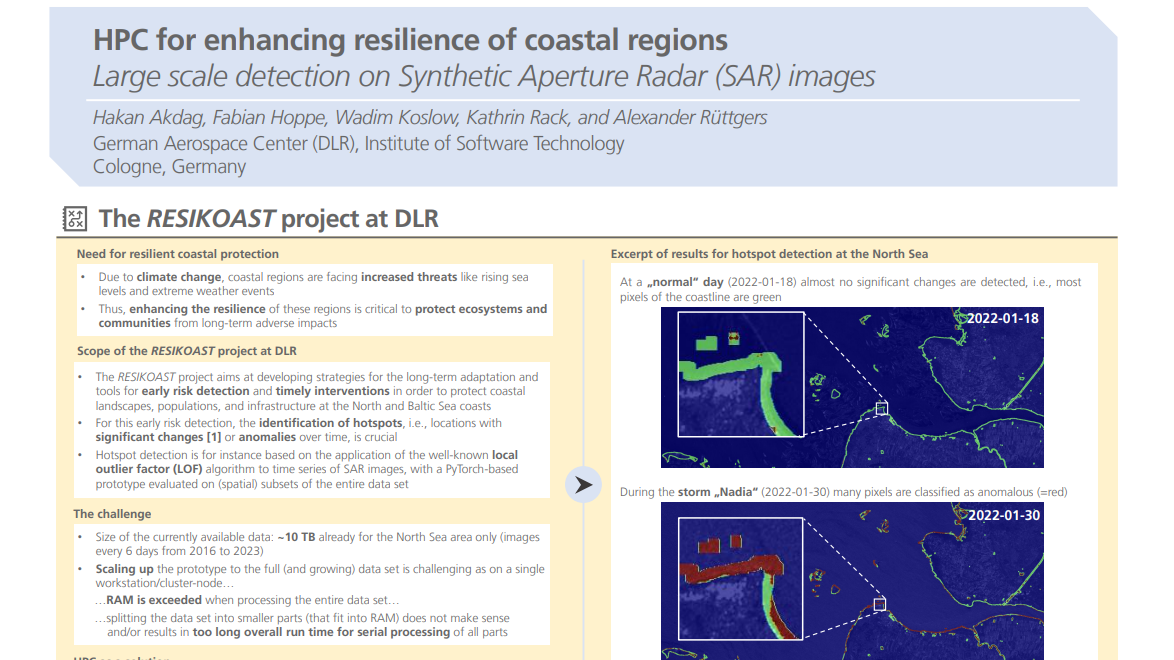

HPC for Enhancing Resilience of Coastal Regions - Large Scale Detection on Synthetic Aperture Radar (SAR) Images
Tuesday, June 10, 2025 3:00 PM to Thursday, June 12, 2025 4:00 PM · 2 days 1 hr. (Europe/Berlin)
Foyer D-G - 2nd floor
Research Poster
Extreme-scale AlgorithmsGeosciences and Energy GenerationHigh-Performance Data Analytics
Information
Poster is on display and will be presented at the poster pitch session.
Coastal regions face increasing risks due to climate change, including rising sea levels and more frequent extreme weather events. These challenges threaten ecosystems, populations, and infrastructure, necessitating innovative approaches for early risk detection and intervention. However, the vast amounts of data required for such analyses, such as Synthetic Aperture Radar (SAR) imagery, present significant computational challenges. For example, SAR datasets for the North Sea alone exceed 10 terabytes, and traditional single-node processing approaches are infeasible due to memory constraints and excessive runtimes.
To address this issue, the RESIKOAST project, conducted by the German Aerospace Center (DLR), employs high-performance computing (HPC) to enable large-scale environmental monitoring. The project leverages the HElmholtz Analysis Toolkit (HEAT), an open-source Python library for parallel array computing, which is designed to efficiently process massive datasets in multi-node, multi-GPU settings. An important contribution of the project is the adaptation of the Local Outlier Factor (LOF) algorithm for memory-efficient, parallel processing to identify “hotspots” — locations with significant temporal changes or anomalies in SAR imagery.
Scalability and performance of this approach were evaluated on DLR’s Terrabyte cluster. Experiments included processing approximately 840 GB of data, calculating LOFs for 12 million locations, and clustering 4.3 billion data points. Results demonstrate that HEAT’s parallelized implementation successfully overcomes memory and runtime limitations, enabling efficient analysis of large datasets.
By harnessing HPC, RESIKOAST demonstrates how advanced computational techniques can address the challenges of large-scale environmental monitoring, providing a scalable and effective solution for enhancing coastal resilience through efficient anomaly detection.
This research was supported by the European Space Agency through the Open Space Innovation Platform https://ideas.esa.int as a Early Technology Development Agreement and carried out under the Discovery Program ESA Early Technology Development (Research Agreement No. 4000144045/24/NL/GLC/ov). Disclaimer: The view expressed in this publication can in no way be taken to reflect the official opinion of the European Space Agency.
Coastal regions face increasing risks due to climate change, including rising sea levels and more frequent extreme weather events. These challenges threaten ecosystems, populations, and infrastructure, necessitating innovative approaches for early risk detection and intervention. However, the vast amounts of data required for such analyses, such as Synthetic Aperture Radar (SAR) imagery, present significant computational challenges. For example, SAR datasets for the North Sea alone exceed 10 terabytes, and traditional single-node processing approaches are infeasible due to memory constraints and excessive runtimes.
To address this issue, the RESIKOAST project, conducted by the German Aerospace Center (DLR), employs high-performance computing (HPC) to enable large-scale environmental monitoring. The project leverages the HElmholtz Analysis Toolkit (HEAT), an open-source Python library for parallel array computing, which is designed to efficiently process massive datasets in multi-node, multi-GPU settings. An important contribution of the project is the adaptation of the Local Outlier Factor (LOF) algorithm for memory-efficient, parallel processing to identify “hotspots” — locations with significant temporal changes or anomalies in SAR imagery.
Scalability and performance of this approach were evaluated on DLR’s Terrabyte cluster. Experiments included processing approximately 840 GB of data, calculating LOFs for 12 million locations, and clustering 4.3 billion data points. Results demonstrate that HEAT’s parallelized implementation successfully overcomes memory and runtime limitations, enabling efficient analysis of large datasets.
By harnessing HPC, RESIKOAST demonstrates how advanced computational techniques can address the challenges of large-scale environmental monitoring, providing a scalable and effective solution for enhancing coastal resilience through efficient anomaly detection.
This research was supported by the European Space Agency through the Open Space Innovation Platform https://ideas.esa.int as a Early Technology Development Agreement and carried out under the Discovery Program ESA Early Technology Development (Research Agreement No. 4000144045/24/NL/GLC/ov). Disclaimer: The view expressed in this publication can in no way be taken to reflect the official opinion of the European Space Agency.
Format
On DemandOn Site

